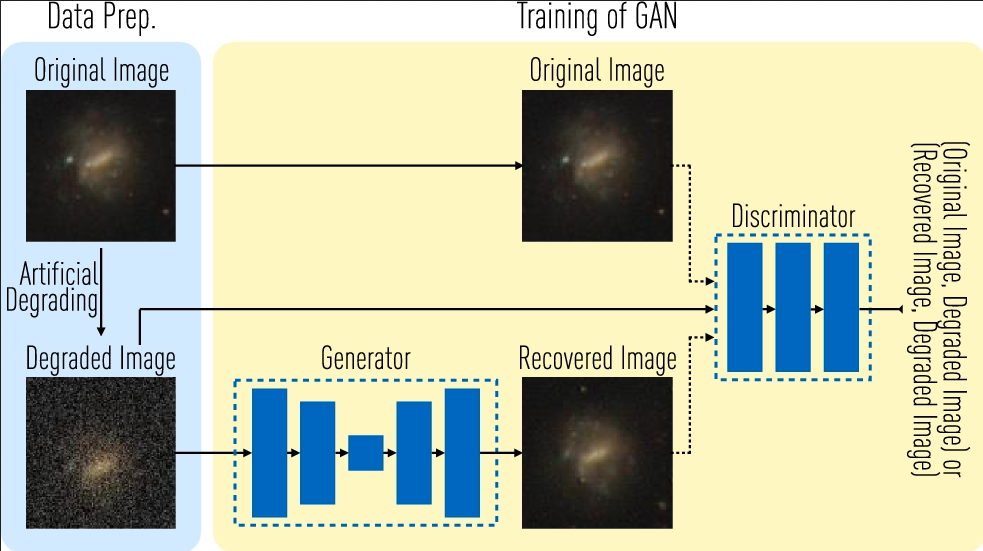Neural networks promise sharpest-ever telescope images
February 27, 2017

From left to right: an example of an original galaxy image; the same image deliberately degraded; the image after recovery by the neural network; and for comparison, deconvolution. This figure visually illustrates the neural-networks’s ability to recover features that conventional deconvolutions cannot. (credit: K. Schawinski / C. Zhang / ETH Zurich)
Swiss researchers are using neural networks to achieve the sharpest-ever images in optical astronomy. The work appears in an open-access paper in Monthly Notices of the Royal Astronomical Society.
The aperture (diameter) of any telescope is fundamentally limited by its lens or mirror. The bigger the mirror or lens, the more light it gathers, allowing astronomers to detect fainter objects, and to observe them more clearly. Other factors affecting image quality are noise and atmospheric distortion.
The Swiss study uses “generative adversarial network” (GAN) machine-learning technology (see this KurzweilAI article) to go beyond this limit by using two neural networks that compete with each other to create a series of more realistic images. The researchers first train the neural network to “see” what galaxies look like (using blurred and sharp images of the same galaxy), and then ask it to automatically fix the blurred images of a galaxy, converting them to sharp ones.

Schematic illustration of the neural-network training process. The input is a set of original images. From these, the researchers automatically generate degraded images, and train a GAN. In the testing phase, only the generator will be used to recover images. (credit: K. Schawinski / C. Zhang / ETH Zurich)
The trained neural networks were able to recognize and reconstruct features that the telescope could not resolve, such as star-forming regions and dust lanes in galaxies. The scientists checked the reconstructed images against the original high-resolution images to test its performance, finding it better able to recover features than anything used to date.
“We can start by going back to sky surveys made with telescopes over many years, see more detail than ever before, and, for example, learn more about the structure of galaxies,” said lead author Prof. Kevin Schawinski of ETH Zurich in Switzerland. “There is no reason why we can’t then apply this technique to the deepest images from Hubble, and the coming James Webb Space Telescope, to learn more about the earliest structures in the Universe.”
ETH Zurich is hosting this work on the space.ml cross-disciplinary astrophysics/computer-science initiative, where the code is available to the general public.
Abstract of Generative adversarial networks recover features in astrophysical images of galaxies beyond the deconvolution limit
Observations of astrophysical objects such as galaxies are limited by various sources of random and systematic noise from the sky background, the optical system of the telescope and the detector used to record the data. Conventional deconvolution techniques are limited in their ability to recover features in imaging data by the Shannon–Nyquist sampling theorem. Here, we train a generative adversarial network (GAN) on a sample of 4550 images of nearby galaxies at 0.01 < z < 0.02 from the Sloan Digital Sky Survey and conduct 10× cross-validation to evaluate the results. We present a method using a GAN trained on galaxy images that can recover features from artificially degraded images with worse seeing and higher noise than the original with a performance that far exceeds simple deconvolution. The ability to better recover detailed features such as galaxy morphology from low signal to noise and low angular resolution imaging data significantly increases our ability to study existing data sets of astrophysical objects as well as future observations with observatories such as the Large Synoptic Sky Telescope (LSST) and the Hubble and James Webb space telescopes.